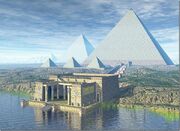The 28th and 27th Centuries are the third section of the Bronze Age of history.
| Bronze Age Pt. 2: 3000-2801 BCE |
Bronze Age Pt. 3 2800-2601 BCE |
Bronze Age Pt. 4: 2600-2401 BCE |
Egypt[]
With Hotepsekhemwy taking hold of the Pharaoh's throne, records show that his first issues was settling down and stabilizing the kingdom that he had just taken control of. Hotepsekhemwy's biggest accomplishment was establishing the Netjer-Achty, or the "Chapel of the White Crown", in Buto. The chapel's main purpose was to affirm his power as the ruler of Egypt and cementing Hotepsekhemwy's heritage from the Upper Kingdom of Egypt. With Raneb, Hotepsekhemwy's son, he secured and solidified the throne for the Second Dynasty. Most records date that most of Raneb's reign was spent helping rebuild the Egyptian economy after years of rebuilding the army and the destroyed cities during his father's uprising and reign.
Egypt would meet another troubling moment in time. When Nynetjer took the throne after succeeding his father, he created a heavy system of integrated administration. Putting on a heavy tax and toll on the peasants and nobles of the kingdom. It would not help that during his reign Egypt would suffer one of its severest droughts in history after mismanagement with the irrigation technique of the Nile. Nynetjer would leave Egypt in a troubling time, he would crown his first son Wadjenes the next Pharaoh and the King of Lower Egypt, while his second born, Weneg, would be crowned King of Upper Egypt. Nynetjer's thought was that dividing up the kingdom would allow his son's the ability to effectively govern the kingdom and fix the problems that he had built. Within the first decade Weneg would declare war against Lower Egypt and pronounced himself the true. After a 5 Year Civil War, Weneg would die in battle, leaving Wadjenes the true and only Pharaoh, allowing him to reunite the kingdom under his crown. With Wadjenes reuniting his kingdom, he spent the rest of his reign rebuilding it, as it was another civil war that had occurred in the past 200 years of Egypt's history.
When Senedj took to the throne no advisors would expect his reign to be great. Though Senedj would be known as The Great Architect, with the constructions of the Pyramids of Giza and the Great Sphinx. These statues reaffirmed his kingdoms greatness for all to see, scripts tell of traders coming into the kingdom and seeing these great tombs of stone and being awed and amazed by their greatness. Senedj's move to build the Pyramids and Sphinx proved risky, but it promoted the need for better schooling, better tools, better measurement systems, and better farming for the workers. He would never see all of his creations fully built, as scripts from his advisors tell, he would live until those tombs were built. He unfortunately died 3 years after construction began.
"I will not pass on to meet my former kings, until they find a resting place that they can call their own."

Artist representation of the Pyramids of Giza after complete construction
Indus Valley[]
In what is now the Persian province of Hindustan, the population of the region flourished as many more cities were formed. In what was known as the Indus Valley Civilization, over 2500 cities were formed. There was no main government that ruled at the time, but each city had their own similar system of worship. Around this time, there are myths of small Mesopotamian trade ships reaching these cities to trade around this time. Historians believe it could have been motivation to explore because of Egyptian expansion, but whatever else was founded quickly fell after contact.
The main cities in the region bustled, and were estimated to have tens of thousands of people in each. These cities included Harappa, Ganeriwala, and Mohenjo-Daro, which all traded with one another through the invention of the wheel. This civilization relied heavily on trade. Barter communities formed, and the Indus Valley was the biggest it would get until it's demise in then coming millennium.
China[]
The first real records recorded of Chinese history began in 2697 BCE, when the Yellow Emperor, Huangdi, took power over most of China. Huangdi was the first true ruler of all of China after many centuries of being divided between what was known as the Three Sovereign Kingdoms. The few records on Huangdi portray him as the great unifier and thinker, able to solve any problem with a new idea or invention. Hunagdi was also known as the one who helped create the knowledge on how to make tea using the right plants. Then helped unlock China's greatest export in history, Silk.
However, after Huangdi's death, many of the Chinese cities and nobles would fall back into warring states, his teachings and ideals would be passed on to the various Dynasties that followed after his own.
Rest of the World[]
Cities all over the world grow, with Caral becoming the center of trade for the Pre-Inca peoples. In Sumer, the events that the Epic of Gilgamesh is based off of occur, and the cities in the region grow and begin to trade with Egypt. Some ships go off on exploration missions in search of Egyptian ports, leading to a few small communities on the Arabian peninsula.
| |||||
| |||||||||||||||||


